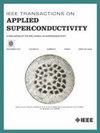Design of HOM Damped Multi-Cell SRF Cavities for CW Operation in High Current Storage Rings
IF 1.7
3区 物理与天体物理
Q3 ENGINEERING, ELECTRICAL & ELECTRONIC
引用次数: 0
Abstract
Currently, superconducting RF (SRF) systems for high-current storage rings are generally limited to low-frequency, moderate voltage, and single-cell cavities. For a new class of cavities to be used in longitudinal beam phase-space manipulation, high-voltage third harmonic multi-cell cavities are required, resulting in very challenging impedance considerations and higher-order mode (HOM) powers of the order of several kW per cavity. Thus, the cavity design requires far more attention on the HOM spectrum to be off-resonance with circulating beam harmonics. Special techniques have been developed to analyze the HOM spectrum and damping beyond the standard frequency range, which typically lies at a few GHz, as required by the VSR Demo project. Within the presented work, a four-cell 1.5 GHz cavity is designed including end-groups with multi-waveguide damping for a space-saving design capable of handling over 2.5 kW of HOM power per cavity. These cavities are designed for high-voltage operation with beam currents of at least 300 mA. Prototype systems are now in production. This article provides an overview of the advanced techniques for SRF cavity design and their application to tailoring the HOM spectrum and its application for the VSR Demo project.大电流存储环中连续波工作的HOM阻尼多单元SRF腔的设计
目前,用于大电流存储环的超导射频(SRF)系统通常局限于低频、中压和单细胞腔。对于用于纵束相空间操作的新型腔体,需要高压三次谐波多腔体,这导致了非常具有挑战性的阻抗考虑和每个腔数kW的高阶模式(HOM)功率。因此,腔体设计需要更多地关注homm频谱与循环光束谐波的非共振。根据VSR演示项目的要求,已经开发了特殊技术来分析HOM频谱和超出标准频率范围的阻尼,标准频率范围通常位于几GHz。在提出的工作中,设计了一个四单元1.5 GHz腔,包括具有多波导阻尼的端组,以节省空间,每个腔能够处理超过2.5 kW的homm功率。这些腔体设计用于高压操作,光束电流至少为300毫安。原型系统现已投入生产。本文概述了SRF腔体设计的先进技术及其在定制homm频谱中的应用,以及它在VSR演示项目中的应用。
本文章由计算机程序翻译,如有差异,请以英文原文为准。
求助全文
约1分钟内获得全文
求助全文
来源期刊

IEEE Transactions on Applied Superconductivity
工程技术-工程:电子与电气
CiteScore
3.50
自引率
33.30%
发文量
650
审稿时长
2.3 months
期刊介绍:
IEEE Transactions on Applied Superconductivity (TAS) contains articles on the applications of superconductivity and other relevant technology. Electronic applications include analog and digital circuits employing thin films and active devices such as Josephson junctions. Large scale applications include magnets for power applications such as motors and generators, for magnetic resonance, for accelerators, and cable applications such as power transmission.
 求助内容:
求助内容: 应助结果提醒方式:
应助结果提醒方式:


